Kerala Plus One Botany Chapter Wise Previous Questions Chapter 6 Cell Cycle and Cell Division
Question 1.
The following are some of the important events in mitotic cell division. Mention the stages of mitosis during which these events happen. (MARCH-2010)
i) Centromeres split and chromosomes separate.
ii) Chromosomal material condenses to form compact mitotic chromosomes.
Answer:
i) Anaphase
ii) prophase
Question 2.
What is a quiescent stage: (MARCH-2010)
Answer:
It is the inactive stage of cell cycle . In this stage cells do not proliferate but they are in metabolically active state.
Question 3.
Mention the importance of crossing over. (MARCH-2010)
Answer:
This process helps in the exchange genes and promote genetic variation.
Question 4.
A diagram prophase I stage of a Meiosis is given below. Draw similar diagrams to illustrate the following stages: (SAY-2010)
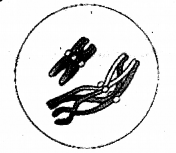
a) Metaphase I
b) Telophase I
c) Anaphase II
Answer:
a) Metaphase I
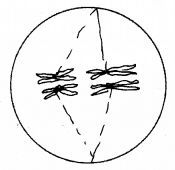
b) Telophase I
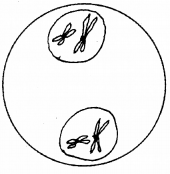
c) Anaphase II
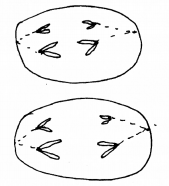
Question 5.
Mitosis is divided into four stages: Prophase is the first stage of mitosis and is the second stage. (MARCH-2011)
Answer:
Metaphase
Question 6.
A cell with a chromosome number 42 undergoes mitosis and another cell with 42 chromosomes undergoes meiosis. Give the chromosome number of daughter cells after mitosis and meiosis. Give reasons for your answer. (MARCH-2011)
Answer:
Mitosis results two daughter cells have 42 chromosomes each.lt is the equational division Meiosis results four daughter cells have 21 chromosomes each.lt is the reduction division
Question 7.
Prophase I of meiosis I is subdivided into five phases. The subphases and the chromosome behaviour of the prophase I are listed below. Arrange them in proper order. (SAY-2011)
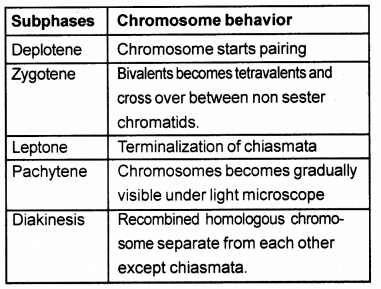
Answer:
1) leptotene stage — The chromosomes become gradually visible under the light microscope
2) zygotene — chromosomes start pairing
3) pachytene — Bivalent becomes tetravalents and cross over occurs between non-sister chromatids
4) Diplotene — recombined homologous chromosomeseparate from each other except chiasma
5) Diakinesis — terminalisation of chiasmata.
Question 8.
Observe the given relation and fill in the blanks. (MARCH-2012)
Meiosis : Reduction division ::
Mitosis : ………
Answer:
Equational division
Question 9.
Observe the given diagram of cell division. (MARCH-2012)
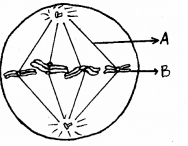
a) Identify the state.
b) Label the parts A and B.
c) Mention any one peculiarity of the pachytene stage of meiosis.
Answer:
a) Metaphase
b) A – Spindle fibre, B-sister chromatids
c) Crossing over occurs between the chromatids of homologous chromosomes. It gives the appearance of recombination nodule.
Question 10.
Given below is the,metaphase of mitosis. Analyze the diagram and draw a sketch of anaphase. Write any two events of anaphase. (MARCH-2017)
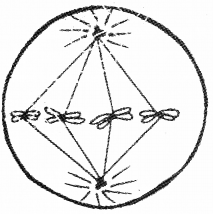
Answer:
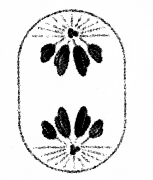
Centromeres split and chromatids separate.
Chromatids move to opposite poles
Question 11.
Observe the diagram given below representing a stage of mitosis. (SAY-2012)

a) Identify the stage.
b) Distinguish it from corresponding stage of meiosis -1.
c) Mention the role of spindle fibers in Mitosis.
Answer:
a) Metaphase
b)

c) Helps in the separation of sister chromatid or Movement of daughter chromosomes.
Question 12.
A diagrammatic view of a cell cycle is given below. (MARCH-2013)

a) Identify the phase in which :
i) DNA synthesis takes place
ii) Chromosomes are arranged at the equator of the spindle
b) Mention two significant points of mitosis in the life of an organism.
Answer:
a) i) S-phase
ii) Metaphase
b) formation of genetically identical daughter cell Growth of multicellular organisms
Question 13.
Observe the following phases of nuclear division during mitosis and answer the following questions: (SAY-2013)
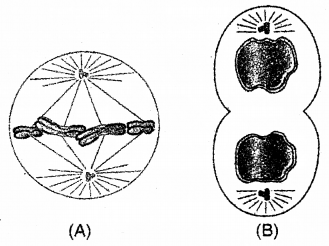
a) Name the two phases of A and B.
b) What are the main events occuring in these two stages?
Answer:
a) A — Metaphase
B — Telophase
b) In metaphase chromosomes are arranged at the equator of the cell. Spindle fibres are attached to the kinetochore of the chromosomes.
In Telophase two daughter nuclei are formed at opposite pole of the cell. Spindle fibre disappeares and nucleolus, nuclear membrane ER and golgi complex reappears.
Question 14.
Prophase of the first meiotic division is typically longer and complex. It has been further subdivided into five phases. The major events of these substages are given below: (MARCH-2014)
a) Pairing of homologous chromosomes.
b) Terminalization ofchiasmata
c) Occurs crossing over
d) Chromosomes are visible under a light microscope
e) Formation ofchiasmata
i) Identify the stages a, b, c, d and e.
ii) Arrange these stages in correct order of occurence.
Answer:
i) a-Zygotene
b – Diakinesis
c – pachytene
d – Leptotene
e- Diplotene
ii)d-a-c-e-b
Question 15.
The diagram shown below represents a stage in mitosis. (SAY-2014)
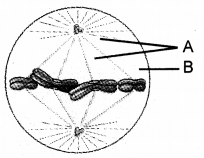
a) Label the parts (A) and (B).
b) Identify the stage.
c) Mention any two events occurring in this stage.
Answer:
a) A- spindle fibres
B- chromosomes
b) Metaphase
c) Chromosomes are arranged at the equator of the cell Spindle fibres arise from the poles and attached to the chromosomes
Question 16.
Observe the diagrammatic view of a cell cycle and answer the questions. (MARCH-2015)
a) Identify the phase in which DNA synthesis takes place.
b) Mention any one event that takes place in the stages marked as ‘x’ and ‘y’.

Answer:
a) s – phase
b) X – metaphase – Chromosomes are arranged at the equator of the cell
Y – Anaphase – Chromosome splits and move towards opposite pole of the cell
Question 17.
Observe the diagram related with cell cycle. (SAY-2015)
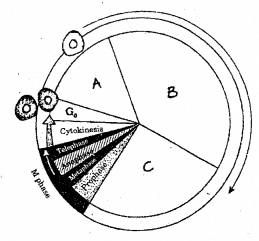
Identify and describe A, B and C in the diagram. (3) (Hint: Description of one point each from A, B, and C)
OR
Write five sub-stages in prophase-l of meiosis. Point out in which sub-stage crossing over occurs,
Answer:
A-G1 phase – post mitotic phase – RNA and proteins are synthesised.
B-S phase – synthetic phase – DNA replication takes place.
C-G2phase – pre mitotic phase – production of RNA and proteins continues for cell growth.
OR
1) leptotene
2) zygotene
3) pachytene-crossing over occurs
4) diplotene
5) diakinesis
Question 18.
a) Identify the substages of meiosis in which crossing over is occuring. (MARCH-2016)
i) Leptotene
ii) Zygotene
iii) Pachytene
iv) Diplotene
b) Summarize the significance of meiosis in sexually reproducing organisms.
Answer:
a) pachytene
b) 1) Meiosis conserves the specific chromosome number of each species across generations in sexually reproducing organisms.
2) It results in reduction of chromosome number by half.
3) It increases the genetic variability from one generation to the next.
4) Variations are very important for the process of evolution.
Question 19.
Identify the substages of Prophase I of meiosis in which the following events takes place. Mention any two significance of meiosis. (SAY-2016)
a) Dissolution of the synaptonemal complex.
b) Crossing over
c) Pairing of homologous chromosome
d) Terminalization of chiasma
Answer:
a) Diplotene
b) Pachytene
c) Zygotene
d) Diakinesis
Significances
- It result in formation of haploid gametes.
- It Increases genetic variability It results in conservation of specific chromosome number in successive generation of a species It results in Reduction in the number of chromosomes
Question 20.
Observe the diagrams. Identity the Aand B stages fo mitosis. Write any two identifying features of each stages. (SAY-2016)

Answer:
A- Metaphase
1. Chromosomes are arranged at the equator of the cell.
2. Spindle fibres are attached, to kinetochore of chromosome
B-Anaphase
1. Centromere split and chromatids separate.
2. Movement of daughter chromosomes towards the opposite poles of the cell
